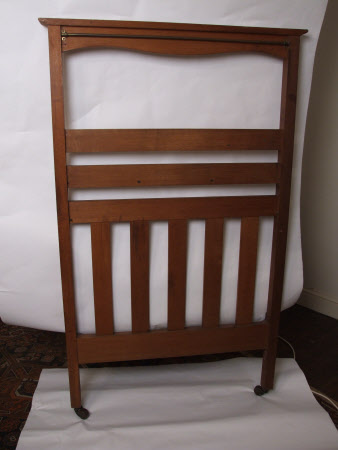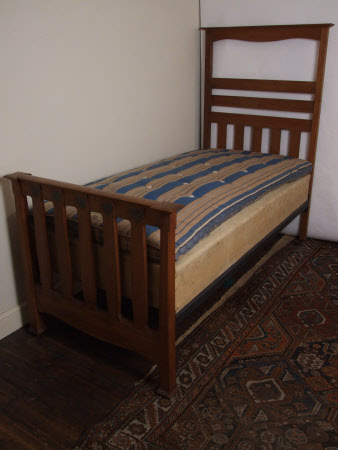Bed head adapted from a design by Ambrose Heal
Sir Ambrose Heal (1872-1959)
Category
Furniture
Date
circa 1900
Materials
Oak
Measurements
65.5 x 38 ins
Order this imageCollection
Shaw's Corner, Hertfordshire
NT 1274869.1
Summary
Heal's oak bed head with five uprights between cross rails, two more cross rails above, and a top rail with a waved edge and cornice. Castor feet. Adapted from the original model. Bernard Shaw’s oak Arts and Crafts bed was originally designed by Ambrose Heal (1872-1959) in 1898 as wooden bedstead ‘no. 117’ to accompany the “Fine Feathers” bedroom suite. The Heal's bed at Shaw's Corner was used by Shaw from 1906 until his death in 1950.
Full description
Bernard Shaw’s oak bed was originally designed by Ambrose Heal (1872-1959) in 1898 as wooden bedstead ‘no. 117’ to accompany the “Fine Feathers” bedroom suite. The bed formed part of Heal’s new furniture collection made by his Cabinet Factory. (Oliver S. Heal, Sir Ambrose Heal and the Heal Cabinet Factory 1897-1939, Wetherby: Oblong, 2014, p.150). Although there is no evidence that Shaw and Ambrose knew each other personally, the two men possibly met at the exhibition of furniture displayed by Kenton & Co. in 1891. (See Stanley Weintraub, ed., Bernard Shaw The Diaries, 1885-1897, vol.2, p.775). In a design that shows the influence of Charles Rennie Mackintosh with the emphasis on the upright slats and verticality, the bed-head retains the original curtain rail at the top (it was designed to incorporate a textile). However the bed-head was either adapted to incorporate the two slats that run horizontally, or was possibly a slightly later model. The embossed oval brass plate ‘Heal & Son’ found on the bottom rail (of the bed head) was used in the years around 1900. The bed-end is decorated with pewter and ebony inlays in a heart-shaped design mirroring the typical Arts and Crafts motif found on the staircase at Shaw’s Corner. This striking design was among those celebrated in a special catalogue published in 1898, A Note on Simplicity in Design in Furniture for Bedrooms with Special Reference to Some Recently Produced by Messrs. Heal and Son. Originally made in mahogany, the oak version of the bed was only available from 1900 to 1907, having been designed to match the “Fine Feathers Suite” which was being discontinued around 1906. (Oliver S. Heal, Sir Ambrose Heal, p.157). The bed would have been purchased by the Shaws prior to the move to Shaw’s Corner, as a bed for Shaw during the period of renting other country houses in the years 1900-1906. It was then brought to Ayot in 1906. It is significant that although the Shaws rented most of the furniture at Shaw’s Corner from 1906 until their purchase of the house in 1920, this arrangement did not include their beds. Shaw used the bed by Ambrose Heal throughout the period at Shaw’s Corner from 1906 until his death. Shaw eventually died in the bed after it was brought downstairs to the dining-room during his final illness, visible in various press photographs taken in November 1950. As a socialist, Shaw appreciated that craftsmen such as Heal were trying to engage new consumers by making their products more affordable in the early 20th century, taking the ethical principles of the Arts and Crafts and applying them to more commercial production. The Heal’s catalogue of 1905 Simple Bedroom Furniture, stated that their aim was to unite ‘the many good qualities of the past with inexpensiveness’, producing furniture that would ‘come within the means of the modest man, and yet be well-constructed, simple, convenient and entirely satisfying to the senses.’ (Egan Mew, in Simple Bedroom Furniture, 1905, quoted in Oliver S. Heal, Sir Ambrose Heal, p.70). Ambrose Heal, like Shaw, was strongly influenced by William Morris, and believed in producing simple, useful furniture to high standards. This approached Morris’s ideal of honest craftsmanship at reasonable prices. Shaw made his views clear in a letter he later wrote to his old friend the silversmith and architect Henry Wilson: “artistic furniture could be produced well and cheaply by Tottenham Court Road tradesmen like Heal…” (Shaw to Henry Wilson, 10 August 1915, Bernard Shaw Collected Letters, vol.3, p.306). Shaw felt that the products of Heal’s were socially progressive because they operated on a more commercial level, offering quality and value for money, but were also ‘artistic’. Throughout their married life the Shaws had an account at the Heal’s shop at Tottenham Court Road, and Charlotte’s diaries record frequent visits there, some trips made with Shaw. Further examples of Heal’s furniture were purchased by the Shaws for Ayot according to photographic and archival evidence. During the mid-1920s the Shaws also acquired a Heal’s Arts and Crafts rush-seated writing chair, designed by Ambrose and made by the cabinet factory. The original chair was sold by the National Trust in 1954, but another chair has recently been acquired in the same design. (NT 1275653). Various smaller examples of Heal’s products were purchased by the Shaws for Ayot, including curtain rings and brackets; and Charlotte’s personal papers at the British Library also reveal that she had shares in Heal & Son Limited. (British Library Add. MSS 63198 B-C). (Alice McEwan, 2020)
Provenance
The Shaw Collection. The house and contents were bequeathed to the National Trust by George Bernard Shaw in 1950, together with Shaw's photographic archive.
Marks and inscriptions
On metal label on bottom rail: "HEAL and SON 196 TOTTENHAM CT ROAD LONDON"
Makers and roles
Sir Ambrose Heal (1872-1959), designer Heal and Son, manufacturer

